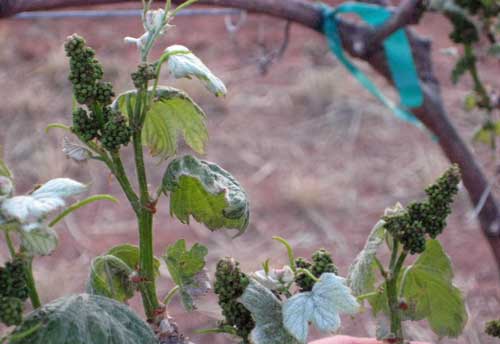
![]()
The New Texas Wine Lexicon: Better Start Asking if You Want Breakfast, Lunch or Dinner Wines; They are Coming!
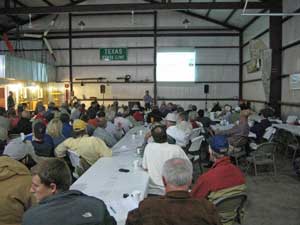 This past week, I was visiting the Texas high plains, first on a bus tour of the new vineyard popping up in Terry County. Then, I attended the Newsom field day and sat with over two hundred winegrowers and winery representatives to discuss new grape varieties, growing techniques and tasted a wide variety of new Texas wines. I thought to myself, “What a difference a year makes in Texas wine country”. Texas is well known in history and lore for its ‘yo-yo’ weather and also for the grit and determination of its people and their pioneering spirit. This is something fellow Texans should be proud of and support, especially when they go to their favorite wine store.
This past week, I was visiting the Texas high plains, first on a bus tour of the new vineyard popping up in Terry County. Then, I attended the Newsom field day and sat with over two hundred winegrowers and winery representatives to discuss new grape varieties, growing techniques and tasted a wide variety of new Texas wines. I thought to myself, “What a difference a year makes in Texas wine country”. Texas is well known in history and lore for its ‘yo-yo’ weather and also for the grit and determination of its people and their pioneering spirit. This is something fellow Texans should be proud of and support, especially when they go to their favorite wine store.
The Difference a Year Makes
Last year by this time, Texas wine growers experienced a couple early March weeks in the eighties that started shoots a-shooting out long and buds-a-breaking. Unfortunately, this was followed by the hard backhanded slap of sub-freezing nights in the low twenties. This situation left growers with only 30 percent or, in some cases, even less of a crop of Texas wine grapes. In some varieties, damaging hardwood winterkill in canes and cordons have led to replantings. These replantings are focusing on different varieties of wine grapes this year.
In contrast, this year there has been a deep cold winter dormancy of the vines that was followed by a long, slow spring without killer freezes that is conducive to a large crop. It might even be what some are saying under their breadth could be the “Vintage of the Century” for Texas wine grapes. Yet, nobody dares say this out loud because we are not past the early hail period that usually lasts thorough the first days of summer. While these feelings are thus far muted, there are very high hopes. These hopes for what could be the largest crop of Texas grapes in modern history. This is why I say, Texans better start thinking about which wine they will drink with breakfast, lunch and dinner.
Need for a New Texas Wine Lexicon
In more critical terms, Texas wine consumers will be faced with an increasing number of wines made from varieties of grapes that aren’t the usual and recognizable grapes of Bordeaux or Burgundy (e.g. Cabernet, Chardonnay and Merlot). However, these will be wines made from grapes that are better suited for Texas’ growing conditions. They will make more consistent, high quality wines, some of which may well be actually suited for breakfast, lunch and dinner.
For example, in the Piemonte (Piedmont) wine region of northern Italy, they openly refer to this “breakfast, lunch and dinner” distinction based on the three dominant red grape varietals grown there: Dolcetto, Barbera and Nebbiolo. From these grapes, they have three styles of wines (from light to full body) depending on the occasion or even perhaps the meal of day:
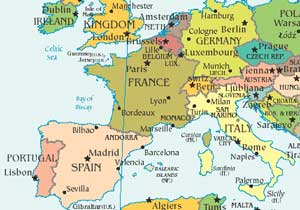 Breakfast Wine – What they refer to as “breakfast wine” is made in a light, fruity style from Dolcetto. Often vineyard workers start early in the field, before breakfast is served and when they return for their morning meal, they commonly imbibe a glass of Dolcetto.
Breakfast Wine – What they refer to as “breakfast wine” is made in a light, fruity style from Dolcetto. Often vineyard workers start early in the field, before breakfast is served and when they return for their morning meal, they commonly imbibe a glass of Dolcetto.
Lunch Wine – These workers then depart to continue their field work coming back for lunch accompanied with a goblet of Barbera that is somewhat more intense and darker than Dolcetto, perhaps with a slight touch of oak aging.
Dinner Wine – Still later, after their day’s work is complete, dinner is very typically a hearty meal with pasta, mushrooms, truffle, grilled meats and cheeses. It is served with the king of Piemonte red wines, Barolo made from full bodied and heavily oaked and aged Nebbiolo.
Texas, like everywhere else in the wine world outside Piemonte, has no claim to making great Barolo-style Nebbiolo wines. However, it does have a growing list of wines made from varietals that derive from warm southern European climes ranging from Italy, Sardinia, and southern France to Spain. These are new types of grapes to Texas, but they love the Texas sun, the warmth of our summers, and some even know how to better handle the late spring freezes that turns Chardonnay and Cabernet vines into dry, crispy chards. The new varietals either bud out later or can make a decent crop on secondary buds.
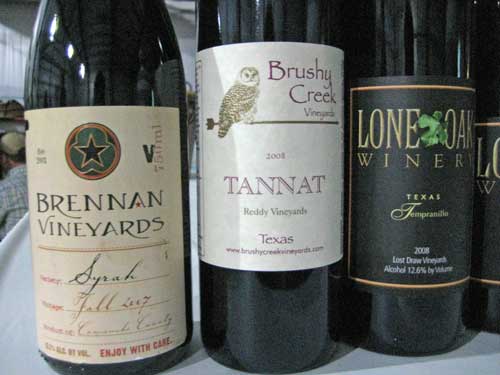
The New Texas Wine Lexicon
Now that the expectations for the Texas 2010 vintage are up, it will be up to Texas consumers to belly up, sort through the new wine names and styles, then taste these new Texas wines to find their favorites. Here is what I call the New Texas Wine Lexicon complete with wines for “breakfast through dinner”.
Light Body and Fruit Character – “Breakfast Wines”
Red Wines
Dolcetto – A red grape widely grown in Piedmont region of Italy having dark berry aromas and flavors reminiscent of nuts and liquorice. Made to drink young with low acidity and tannins needing little or no oak aging for easy drinking.
Dry Rosé (not a single variety, but made from warm weather grapes like Sangiovese, Syrah, Grenache or Mourvedre or blends) – This is the preferred summertime quaff in southern Europe. More are being made in Texas; they are pretty, pink-to-red in color, but are not sweet “blush” wine. Rosés are made crisp and dry for maximum Texas summertime refreshment.
White Wines
Vermentino – Grape famously grown on the terraced vineyards of the Liguria region of Italy and also widely grown in Sardinia and Corsica. It is usually used to produce aromatic varietal wine of light or medium body, or blended with other dry white wines like Sauvignon Blanc.
Muscat (Canelli or Giallo) – White wines known to have a unique aromatic character mostly used for making medium-sweet and dessert style table or fortified wines of Italy, but can be made in a dry or off-dry still or sparkling wines. Responds well in warm climates and can be blended with Sauvignon Blanc, Chenin Blanc, Chardonnay, etc.
Medium Body and Favor – “Lunch Wines”
Red Wines
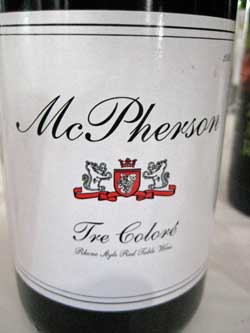 Sangiovese – Best-known red grape grown in Italy from the Tuscany region used to produce the Chianti and other Tuscan red wines, including Brunello. Most commonly used in medium-bodied reds with rich cherry flavors, cola aromas and good acidity. Makes extremely compatible wines with food.
Sangiovese – Best-known red grape grown in Italy from the Tuscany region used to produce the Chianti and other Tuscan red wines, including Brunello. Most commonly used in medium-bodied reds with rich cherry flavors, cola aromas and good acidity. Makes extremely compatible wines with food.
Barbera – Red grape commonly grown in the Piedmont region of northern Italy and in Sardinia. Provides intense red color, low tannins and high acid. In USA, it first developed a reputation for jug wines, but more recently it is made into robust red wines of medium body with intense fruit characteristics and moderate oak aging.
Syrah/Shiraz – A grape variety from the Rhone Valley region of France famous for creating “Hermitage” red wine. More recently, this varietal has been grown successfully in Australia known for its fruity style by the popular term – Shiraz. It is a flexible grape variety that can be made into medium body and intensely fruit driven wines.
Nero d’Avola – One of the grapes blended into well-regarded Sicilian red wines capable of being grown in warm wine regions like Texas. It develops medium to full body with excitingly rustic characteristics when young that develop further with aging into complex aromas.
White Wines
Roussanne – White grape variety grown in the Hermitage-Rhone and southern Cotes du Rhone region of France. Light to medium body wine and can be blended with Marsanne for richer-bodied wine experiences. Crisp acidity and floral aromas but can accept oak aging to give a light Chardonnay-like experience.
Chenin Blanc – A widely grown white-wine producing variety that has been successfully grown in Texas for over thirty years but still awaiting for acceptance. Can be made in a number of wine styles from dry to semi-sweet to sweet with pleasing melon characteristics. Blends well with many other white varietals.
Full Body and Favor – “Dinner Wines”
Red Wines
Tempranillo – Wine grape used in best quality red wines of Spain and Portugal (Rioja, Ribero del Duero, Tinta de Toro). Likes soils rich in limestone like Texas and now with large acreages grown in Texas mostly in the Texas High Plains AVA. Styles include young, fruity with a lighter body, and yet can be made in medium to heavy body with lots of oak aging with great aging potential. Watch for this flexible grape as Texas’ next signature grape.
Mourvedre – Hearty Mediterranean warm climate grape variety widely grown in the southern Rhone region of France (Especially Bandol in Provence) and commonly used in red wine blends. Also called Mataro in Spain.
Tannat – Deeply colored and tannic grape grown originally from the Pyrenees region of France. One of four grapes whose wine is blended to make the full-bodied red wine known as “Madiran” and also widely grown in Uruguay and South America, just now catching on in Texas.
Aglianico – Red wine grape of extreme ancient origin cultivated in Campania region of Italy and responsible for some of the better sturdy red wines of southern Italy, a warm growing region like Texas.
White Wines
Viognier – White grape variety grown in the northern Rhone region of France with full, spicy flavors and floral components. Viognier wine can vary from a Riesling-like character to that of Chardonnay. This is the leading candidate for Texas’ signature white grape that some say will make Texas’s “Chardonnay”.
Marsanne – White grape used in the traditional white wine blends of the French Hermitage-Rhone region. With oak ageing, these wines are capable of long bottle aging like Chardonnay. Often blended with the more aromatic Roussanne to obtain a combination of viscosity, heavier body with interesting floral characteristics.
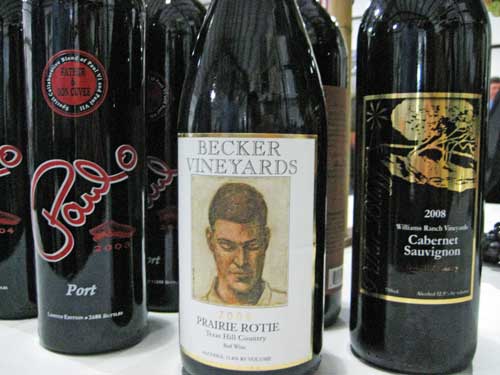
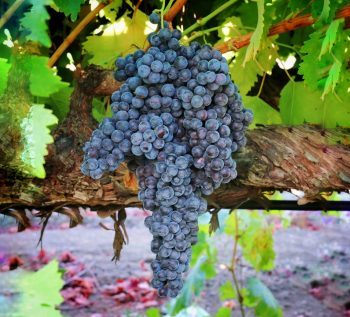


Well written Russ!
Breakfast, lunch and dinner wines at Alamosa Wine Cellars
Breakfast: Amigo White, a table wine with 3% RS made with Orange Muscat…great with eggs and medium hot sausage.
For a red: Rosato di Sangiovese (Italian style Rose)with breakfast tacos
Lunch: Texacaia, a Super Texan style blend with Sangiovese, Syrah and Tempranillo (great with a panini )or Cherokee Rose, Tavel style rose’ made with Mourvedre & Cinsaut, serve with Caesar Salad.
Dinner: White Viognier or Scissortail, a Rhone style blend of Marsanne, Roussanne & Viognier (Salmon or Shellfish)
Red: El Guapo, Tempranillo or Palette, a Rhone style blend of Syrah, Grenache, Mourvedre & Cinsaut. (Steak or Lamb)
Hats off to the Texas wine makers who are embracing these lesser known varietals and setting a new standard for Texas wines. I enjoy the variety being offered and look forward to adding more and more of these wines to our wine list. And as always Russ, you certainly have a way with words!
If you would like some additional information about growing some of these varieties of grapes on the Texas high plains, you can go to:
http://www.binghamfamilyvineyards.com/2010/04/29/high-plains-vineyard-tour-2010/
and
http://www.binghamfamilyvineyards.com/2010/01/30/moscato-giallo/